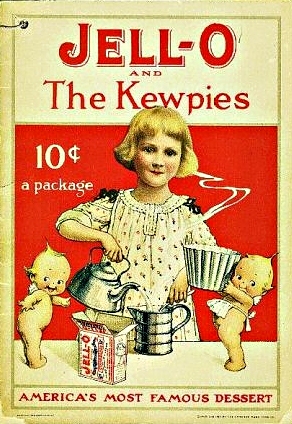Thursday, April 28, 2005
Page 15
REMINISCING (Column)
Jell-O Girl, Kewpies, Benny, Cosby—All Promoted Jell-O
By ROGER M. GRACE
Intensive advertising and other forms of promotion are what carried Jell-O to preeminence among gelatin desserts.
Early in 1900, shortly after the Genesee Pure Food Company bought the product, newspaper advertising commenced. Too, there were demonstrations of the product at fairs, town gatherings, wherever a crowd would be drawn. From 1910-20, immigrants arriving at Ellis Island were served complimentary Jell-O.
Starting in 1904, magazine ads featured the “Jell-O Girl”—Elizabeth King, age 4, daughter of an artist for the advertising agency. Starting that year, Jell-O recipe books with her likeness were distributed, at no cost, in large numbers. Soon came billboards.
“Kewpie dolls” are thought of as prizes won at shooting galleries and pother carnival attractions. Back in 1908, Kewpies were cupids drawn by Rose O’Neill. They began appearing that year in Jell-O ads, and by the time the series ended in 1921, there had been 98 such ads.
Here are cupids pictured on a 1915 booklet with the “Jell-O Girl”:

“The Jell-O Program Starring Jack Benny” aired on NBC radio from Sunday, Oct. 14, 1934 through Sunday, May 31, 1942. At the start of each show, Don Wilson would announce that “the orchestra opens the program with [some current tune]” and, after a few bars, the music would dim and he’d reel off words of adulation of the six flavors of Jell-O, strawberry, raspberry, cherry, orange, lemon and lime.
The commercial mid-way through each show—like the later Lucky Strike pitches on radio, then on TV—were comically woven into the Benny show, rather than being an interruption.
Sponsorship by Jell-O ceased during World War II when sugar was being rationed and there was no point to engendering a desire for a product that was in short supply.
“Jell-O, again,” was Jack Benny’s weekly greeting to listeners. In 1949, there began a variation on that play on the word “hello,” with Lucille Ball offering the salutation “Jell-O, everybody” on her CBS radio comedy, “My Favorite Husband.”
Her radio series started July 23, 1948 as a “sustained” program—that is, it had no sponsor but was aired by the network with the hopes of it acquiring one. Had Jell-O not come along as the benefactor (as of the broadcast of Jan. 7, 1949), the show likely would have perished. The consequence would have been this truly funny series, in which Ball played a batty housewife with a propensity for playing tricks on her husband and getting into jams, would not have served as the springboard for Ball’s TV hit “I Love Lucy.”
(The director, producer and head writer of “My Favorite Husband” was Jess Oppenheimer; other writers were Bob Carroll Jr. and Marilyn Pugh; the musical director was Wilbur Hatch. All played the same roles in the TV series which started in 1951, the year the radio show ended.)
The Aldrich Family and Kate Smith are among other radio shows sponsored by Jell-O.
Bill Cosby has been the Jell-O spokesperson since 1974, appearing in more than 70 television commercials, in addition to delivering radio spiels and appearing in printed advertisements for the product.
But the days of Jell-O’s advertising puns appear to have ended. Never has Cosby been seen in a commercial serenading Dolly Parton with a chorus of “Jell-O, Dolly.”
Copyright 2005, Metropolitan News Company